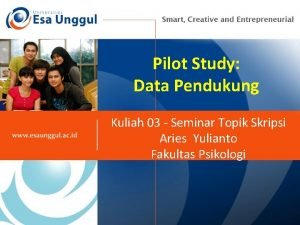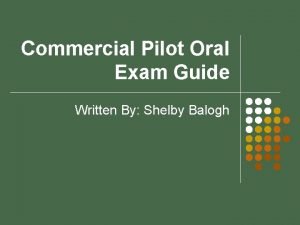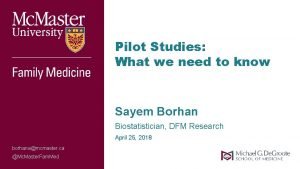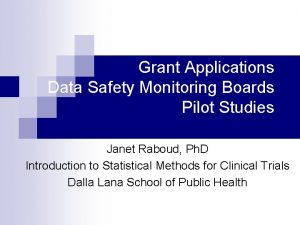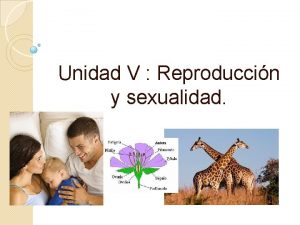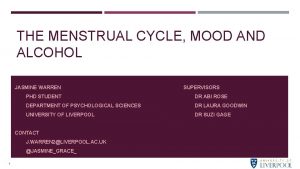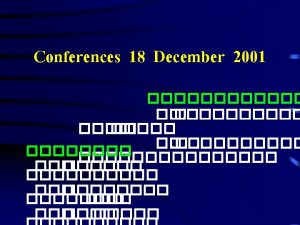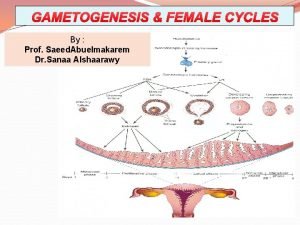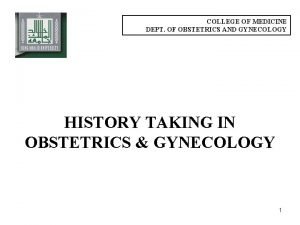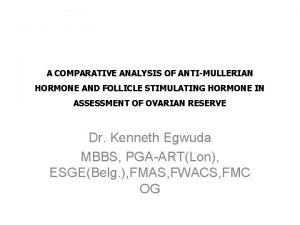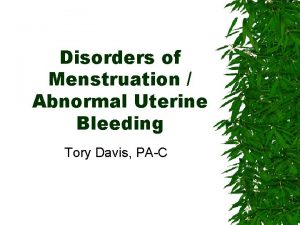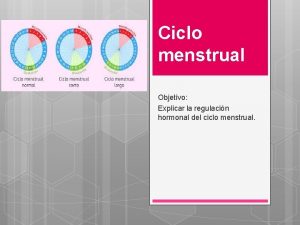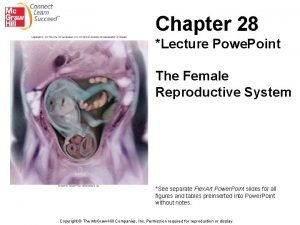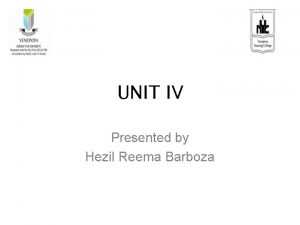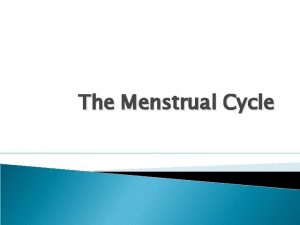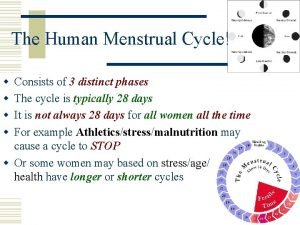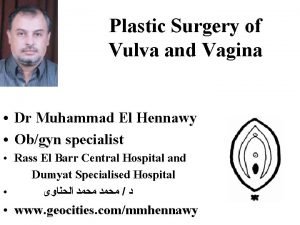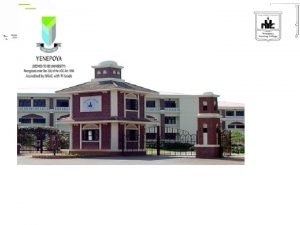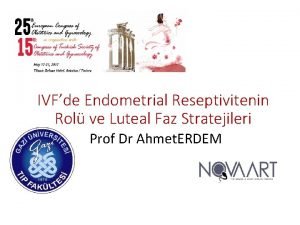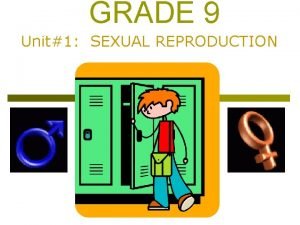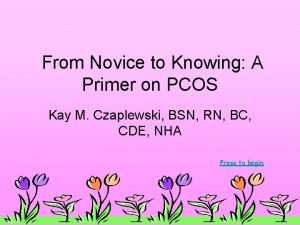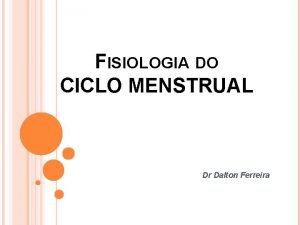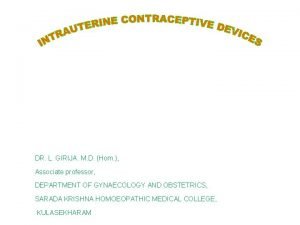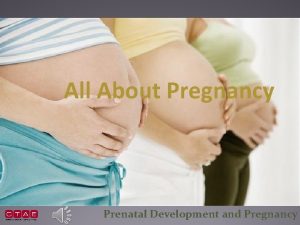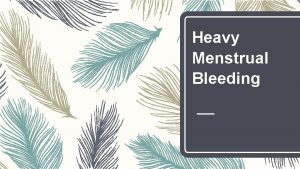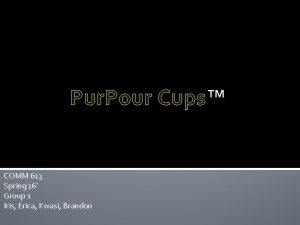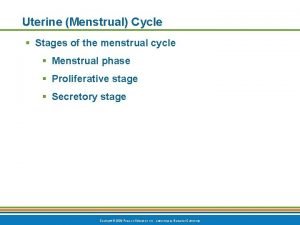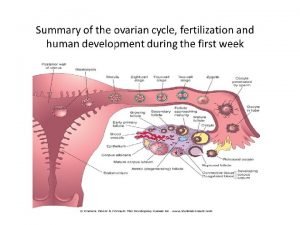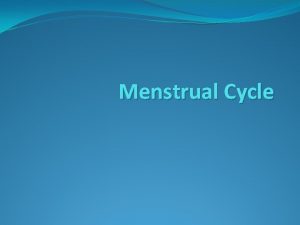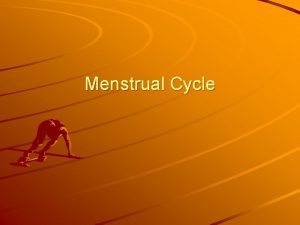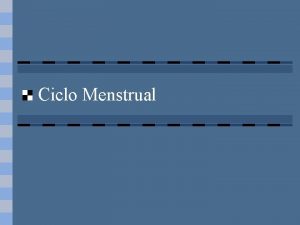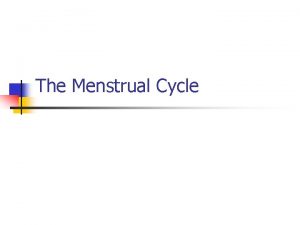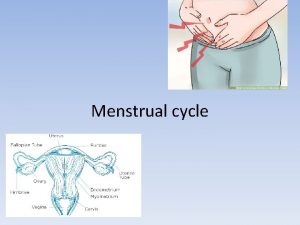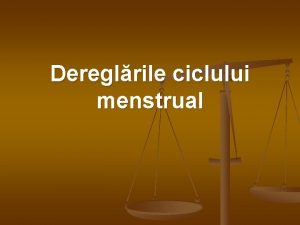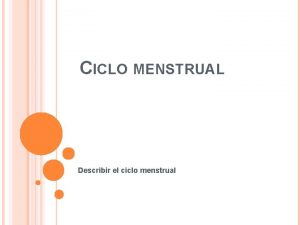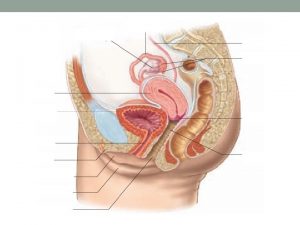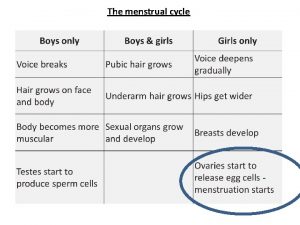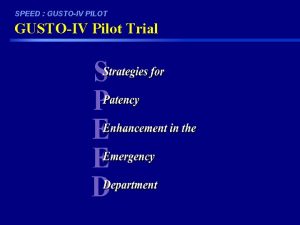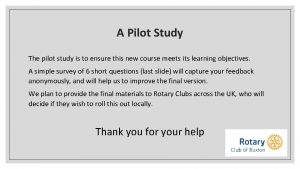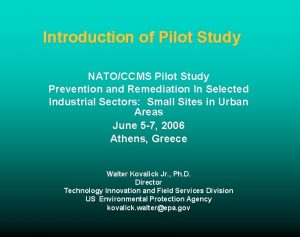Menstrual Cups pilot study and current trial among













































- Slides: 45

Menstrual Cups pilot study and current trial among schoolgirls in western Kenya Penelope Phillips-Howard, on behalf of: Kenya Medical Research Institute, Liverpool School of Tropical Medicine, Safe Water and AIDS Project, and US Centers for Disease Control-Kenya, in collaboration with Government of Kenya Partners Funded by Joint Global Health trials (Medical Research Council; Department for international development; Wellcome Trust)

Background – importance of girls’ schooling School is a ‘social vaccine’ Less HIV, STI, early marriage If all girls graduate GNP > $3. 2 bn/y Education predicts economic output A quarter less girls graduate Drop out ~50% teen pregnancy Menstruation ~500, 000 schooldays/m lost; ? dropout What effect does menstrual-specific vs broader intervention have on adolescent girls’ sexual and reproductive health; school enrolment, retention, attainment (and at what cost)?

Background – effect of girls menstrual needs Leaks, chaffing, smell, itching ‘Your thighs get irritated, you can’t even walk’ ; ‘you start itching it turns to a wound’ ‘it starts stinking makes people uncomfortable’ (girl) Teasing, isolation, fearful, shame, stress ‘I always feel, you are lonely all the times’; ‘you become stressed up…. how you will wash’ (girl) Reduce class engagement, school physical activity ‘Your clothes will be blood stained. . . the teacher will see, hence you don’t concentrate’ (girl) School absence during menses ‘They can absent themselves from school because of the materials …they get embarrassed’ (mother) Economic considerations ‘You pay with your vagina’; ‘You need help, you just engage yourself into sex’ (girls). ‘She will look for this (money for pads) from the men, that is how they can end up with the unwanted pregnancies’ (parent). Source: Mason et al ‘We keep it secret so no one should know’ – A qualitative study to explore young school girls attitudes and experiences with menstruation in rural western Kenya. PLo. S ONE, 8(11): e 79132, 2013

Pilot feasibility study on menstrual items (completed in Siaya County, western Kenya 2013) Design 3 -arm open cluster randomized controlled pilot Measure unit School: randomization girls: assessment Aim Examine acceptability, use, and safety Location Rural primary schools w. Kenya Target population Girls, 14 -16 y, n=~750 Eligibility Consent, assent, 3+ menses Duration Longitudinal 1 school year Outcome School indices, SRH, wellbeing

The menstrual cup (Mooncup®) Bell shaped vessel inserted into vagina to collect menstrual flow Over 75 brands globally, includes Asian and African countries Mooncup® - high grade medical silicone, hypoallergenic, FDA approved (303009117944), UK to ISO 13485: 2003 standards Train girls to hand-wash, insert, empty, clean (boil), store, not lend or sell TSS in Canadian woman with Hashimoto thyroiditis (autoimmune disease) Reported v physical evidence of cup use at screening Pilot: 7% replaced; drop in latrine, rat/burn damage; wrong size 90% 100% 80% 60% 40% 20% 0% 90% 0 1 2 3 Girl reports problem with cup use to nurse Nurse observes cup colour changed 4 5 6 7 Girls self-report cup used all period 8

Participant Flow Diagram Participant exclusions (n=239) ¨ Declined participation (n=40) ¨ Non-eligible (n=199) Assessed for eligibility (n=1005) Enrolment Eligible Participants (n=766) Pads Cups Total Intervention Schools (10) Participants (n=294) ¨ Received (n=288) ¨ Left preintervention (n=6) Intervention Schools (10) Participants (n=229) ¨ Received (n=224) ¨ Left preintervention (n=5) Intervention Schools (30) Participants (n=766) ¨ Received (n=751) ¨ Left preintervention (n=15) Usual Allocation Intervention Schools (10) Participants (n=243) ¨ Received (n=239) ¨ Left preintervention (n=4) Follow-Up Participants (n=239) Lost to follow-up (n=37) ¨ Withdrew (n=6) ¨ Migrated (n=31) Participants (n=288) Lost to follow-up (n=30) ¨ Withdrew (n=2) ¨ Migrated (n=28) Participants (n=224) Lost to follow-up (n=29) ¨ Withdrew (n=8) ¨ Migrated (n=21) Participants (n=751) Lost to follow-up (n=96) ¨ Withdrew (n=16) ¨ Migrated (n=80) Analysis Participants (n=202) ¨ Exclude pregnant preintervention (n=2) ANALYSIS Usual (n=200) Participants (n=258) ¨ Exclude pregnant preintervention (n=2) ANALYSIS Pads (n=256) Participants (n=195) ¨ Exclude pregnant preintervention (n=7) ANALYSIS Cups (n=188) Participants (n=655) ¨ Exclude pregnant preintervention (n=11) ANALYSIS All (n=644) Phillips-Howard PA et al, Menstrual cups and sanitary pads to reduce school attrition, and sexually transmitted and reproductive tract infections: A cluster randomised controlled feasibility study in rural western Kenya, BMJ Open; 6(11): e 013229. 2016

School / WASH findings affecting MHM • Av 10 (6 -21) FT teachers/school; av 420 (154 -1107) pupils/school • Pupil/teacher ratio mean 43: 1 (15: 1 – 75: 1) • Mean 6 latrines/school for boys and same for girls • 75% are pit-latrines; one third had lockable doors • Latrine to pupil ratio - mean 36: 1 (GOK target 25: 1) • 86% of schools separated girls and boys latrine blocks • 2% schools had observable soap for handwashing • 66% of schools had observed water for handwashing • 13% of schools had observed latrine cleaning materials • • 13% of schools had observed water for girls menstrual hygiene Source: Alexander et al Water, sanitation and hygiene conditions in Kenyan rural schools: are schools meeting the needs of menstruating girls? Water, 6: 1453 -1466, 2014 10% gave sanitary pads to girls, 63% never and 23%

WASH - Reported 'always' handwash before/after change study duration: all menstrual groups Source: Nyothach E, et al. Handwashing for menstrual hygiene management among primary schoolgirls in rural western Kenya. Waterlines, 34(4), 279 -295, 2015

WASH and girls dropping of cups and pads Average girl pupil-latrine ratio was 37: 1 (range 11: 1 -70: 1) 971 (17%) instances of accidental dropping of menstrual items Younger girls dropping than older early in study …reversed longer term Source: Oduor C, et al. Schoolgirls’ experiences of changing and disposal of menstrual hygiene items and inferences for WASH in schools. Waterlines, 34(4), 397 -411, 2015.

Schoolgirls’ feedback on effect of cups or pads ‘ Leaks, chaffing, smell, itching ‘I just come to school without fearing of leaking’ ; ‘you insert it you just go to school’ (girl) Teasing, isolation, fearful, shame ‘I do not see her fearful like I used to notice before (mother) Reduce class engagement, school physical activity ‘I’m feeling good because when I put that Mooncup inside I can run, I can do anything’ (girl) School absence during menses ‘she is very free and does not absent herself from school like she used to before’ (mother) Adapting to use ‘use it my daughter I don’t have money, will I be looking. . to buy maize or to buy pads’ (mother); Economic considerations ‘since the Mooncup came, my mum is spending the money wisely sometimes if the fees is needed or even exam fees she can give me. Sometimes she gives me money to buy food at break time’ (girl) Source: Mason L, et al Adolescent schoolgirls’ experiences of menstrual cups and pads in rural western Kenya: a qualitative study. Waterlines special MHM edition, 34: 1; 2015

Prevalence of reproductive tract infections, including sexually acquired, among primary schoolgirls Source: Kerubo E, et al. Prevalence of reproductive tract infections and the predictive value of girls’ symptom-based reporting: findings from a cross sectional survey in rural western Kenya. BMJ-Sex Transm Infect, 92(4): 251 -6, 2016.

Effect of menstrual items on outcomes stratified by use (<12 m>) Phillips-Howard PA et al, Menstrual cups and sanitary pads to reduce school attrition, and sexually transmitted and reproductive tract infections: A cluster randomised controlled feasibility study in rural western Kenya, BMJ Open; 6(11): e 013229. 2016

Safety issues with menstrual product use Severe Events Deaths recorded through HDSS Participant identified to have symptoms of TSS Visited health facility for TSS; other harms Staph aureus and TSS toxin among positives Prevalence of staph aureus Presence of TSST-1 in 2 nd survey positives Cups (n=188) 0 0 0 Cups (n=177) Pads Control Total (n=256) s (n=644 (n=200) ) 0 0 0 0 0 Pads Control Total (n=214) s (n=604) (n=186) 11. 2% 11. 3% 10. 8% 2/3 0/3 2/10 E coli growth prevalence (95% CI) in cups sampled 9. 6% 0/4 Number sample d All cups sampled 35 37. 1% (21. 1%-53. 1%) Cups from new users (less than 6 months) 17 53% (29. 3%-76. 7%) Cups from established users (6 18 cup provided 22. 2% (2. 9%-41. 1%) Source: Juma J, et al, Examining themonths safety of the menstrual to rural plus) primary school girls in Western Kenya, BMJ Open, : e 015429, 2017


METHODOLOGY: CUPS OR CASH FOR GIRLS TRIAL q q q q q 4 -arm cluster randomised controlled trial design Adolescent girls in 84 secondary schools, Siaya County Inclusion: Girls, local residents, attend secondary day school, reach menarche, parent consent, girls assent Stakeholders randomization (cups, cash, cups+cash, contrl) Parent consent, girls assent: trial, HIV/HSV 2 test, store blood Enrolment/baseline survey: demographic, social, sexual risk behaviors; plasma samples obtained for HIV and HSV 2 HIV: serial testing (determine, unigold, ELISA(bio. Rad) tiebreak HSV-2: Herpes Simplex Type 2 Ig. G ELISA (Kalon) Analysis: examine associations between HIV, HSV-2 with age, sexual activity, and other risk factors at baseline

Key outcome indicators

Randomization

18 Study area 2 (2000 km )


Health Day Activity Diagram Last sample drop off for lab 3: 00 pm QUEUE STATION 1 ASSENT STATION 2 BASELINE SURVEY Each assent takes approximately 20 minutes Each baseline survey takes approximately 60 minutes Each desk can do 3 per hour Each tablet can do 1 per hour STATION 3 HIV TESTING AND COUNSELING Each HIV counseling and blood draw takes approximately 30 minutes (post group sensitization) Each desk can do 2 per hour STATION 4 (OPTIONAL) ANTHROPOMETR IC MEASURES Each height and weight measurement takes approximately 6 minutes Each scale can do 10 per hour


Thanks for listening: Q and Thanks A to the field, office, lab teams, schools, girls, ministries, Trial Steering Committee; Data Monitoring and Ethics Committees; other stakeholder partners; Funded by DFID/MRC/Wellcome Trust UK

Menstrual Related: School Participation, Stress & Self-Efficacy Jackie Haver, School Health and Nutrition Sr. Specialist Department of Education and Child Protection Save the Children US FRESH SHN Webinar MHM in Schools 9/8/2021 23

AGENDA • How does MHM link to Girls’ Education • What does the literature tell us? • The process for developing Menstruation Outcome Measures • Qualitative methods & Analysis • Quantitative question development • Results • Next Steps FRESH SHN Webinar MHM in Schools 9/8/2021 24

How does MHM link to Education? In December 17, 2015, the UN General Assembly passed a resolution on water and sanitation stating that a lack of adequate WASH services, “including for menstrual hygiene management, especially in schools, contributes to reinforcing the widespread stigma associated with menstruation, negatively affecting gender equality and women’s and girls’ enjoyment of human rights, including the right to education. ” FRESH SHN Webinar MHM in Schools 9/8/2021 25

MHM and Education What about Attendance? • In Bangladesh girls were more likely to miss school during menstruation if they believed that their menstrual problems impacted their performance in school, attended schools that had locked toilets, or faced restrictions during menstruation (Alam et al. , 2017). • In rural Malawi, 1/3 of girls interviewed missed at least one day of school during their last menstrual period (Grant et al. , 2013). • In Uganda, high school girls and boys missed class equally, but girls were more likely to miss school during their menstrual period (Miiro et al. , 2018) • Studies evaluating the impact of material and education provision on school attendance have yielded mixed results (Oster et al. , 2011; Montgomery et al. , 2012; Montgomery et al. , 2016; Philipps-Howard et al. , 2016). FRESH SHN Webinar MHM in Schools 9/8/2021 26

MHM IMPACTS MORE THAN SCHOOL ATTENDANCE • Northern Tanzania: the onset of menses restricts girls’ ability to participate in social and academic activities…They often experience shame, confusion, and fear, as a result (Sommer, 2009). • Bolivia, Philippines & Sierra Leone: Poor MHM negatively impacts girls’ concentration and participation at school (UNICEF, Emory University, Save the Children, 2013) • Kenya: girls described difficulties engaging in class, due to fear of smelling and leakage, and subsequent teasing (Mason et al, 2013) • Reaching menarche in complete ignorance and in fear may weaken girls’ sense of self-confidence and competence (Williams & Currie, 2000; Short & Rosenthal (2008); Ruble & Brooks-Gunn (1982) FRESH SHN Webinar MHM in Schools 9/8/2021 27

Maybe we should look beyond attendance. FRESH SHN Webinar MHM in Schools 9/8/2021 28

MHM Research questions self-efficacy? Important for behavior change People can be given information, but unless they believe they can do something, they may not change the behavior Decrease menstruationrelated psychosocial stress? Girls talk about fear, embarrassment, teasing and anxiety at school related to MHM Increase menstruationrelated Can a MHM program: Increase School participation? FRESH SHN Webinar MHM in Schools Concentration? Answering question in class? Raising her hand? Skipping a class or parts of class? March 09 2017 29

Can we develop accurate measures for menstruationrelated school participation, stress and self-efficacy? FRESH SHN Webinar MHM in Schools 9/8/2021 30

Phases of MR: SSS Tool Development Menstrual Related: School Participation, Stress and Self Efficacy Phase III Phase IV Qualitative Research in El Salvador and The Philippines Analysis and MR-SSS tool development MR-SSS pilot in El Salvador and tool revision Revised MR-SSS and protocol in The Philippines May – Nov 2016 Data collection: Sept – Dec 2016 Oct 2016 –Feb 2017 MR-SSS pilot: • • Girls boys parents teachers • Focus group discussions • In-depth interviews • Participatory learning activities Analysis of deductive codes and constructs: School Participation Stress Self-efficacy Item and Survey Development: First MR-SSS tool 86 survey questions 9/8/2021 • 200 girls • 13 rural schools • Grades 6 -8 May –Nov 2017 Revised MR-SSS tool and protocol: • 47 survey questions Exploratory Analysis: MR-SSS pilot: • Internal consistency • Mokken scaling • Principle components • Exploratory factor analysis • enumerator training • Back translation • Pre-testing and terminology revision FRESH SHN Webinar MHM in Schools 31

Phases of MR: SSS Tool Development Menstrual Related: School Participation, Stress and Self Efficacy Phase I Qualitative Research in El Salvador and The Philippines May – Nov 2016 Data collection: • • Girls boys parents teachers • Focus group discussions • In-depth interviews • Participatory learning activities Body mapping - Girls drew a heart and a brain and talked about the difference between feelings and emotions 9/8/2021 Timeline of their school day - that was used as a contrast to think about how 32 their day might be different, or not, when they had their period.

Phases of MR: SSS Tool Development Menstrual Related: School Participation, Stress and Self Efficacy Phase II Analysis and MR-SSS tool development Qual Question Sept – Dec 2016 Analysis of deductive codes and constructs: School Participation Stress Self-efficacy Item and Survey Development: Then let’s suppose that in the morning you got your period. Sept-Oct Apr- Aug 2016 Do you think you’ll have the same result on your test? Girl’s response “In my case, it affects me…I feel bored, strange and I don’t feel like studying, but I do what’s Novpossible 2016 and I study but there are times when I forget things and I don’t know why” Survey questions The last three times I had my period… I had a difficult time Jan 2017 concentrating in Jul class 2017 I did not feel like doing my homework First MR-SSS tool 86 survey questions 9/8/2021 FRESH SHN Webinar MHM in Schools 33

Phases of MR: SSS Tool Development Menstrual Related: School Participation, Stress and Self Efficacy Phase III MR-SSS pilot in El Salvador and tool revision Oct 2016 –Feb 2017 MR-SSS pilot: • 200 girls • 13 rural schools • Grades 6 -8 Exploratory Analysis: • Internal consistency • Mokken scaling • Principle components • Exploratory factor analysis 9/8/2021 • Eighty-three questions were piloted • Only 7 of the participation questions met the final alpha requirement. FRESH SHN Webinar MHM in Schools 34

Phases of MR: SSS Tool Development Menstrual Related: School Participation, Stress and Self Efficacy Phase IV Revised MR-SSS and protocol in The Philippines May –Nov 2017 Revised MR-SSS tool and protocol: • 47 survey questions MR-SSS pilot: • enumerator training • Back translation • Pre-testing and terminology revision • 6 schools in Metro Manila • 645 girls sampled, 266 girls had reached menarche and answered the full survey • 301 grade 5 girls (71 reached menarche) • 344 grade 6 girls (202 reached menarche) 9/8/2021 FRESH SHN Webinar MHM in Schools 35

Philippines MR: SSS Assessment Findings FRESH SHN Webinar MHM in Schools 9/8/2021 36

MR-SSS Assessment Findings: School Participation Factor Loadings and Unique Variances Item Description Factor 1 Uniqueness P 4: …you preferred to spend recess alone… 0. 4222 0. 8218 P 5: …you didn’t feel like doing your homework… 0. 5324 0. 7165 P 6: …you didn’t feel like doing anything… 0. 5033 0. 7467 P 7: …when the teacher asked you to go to the board, you asked to be excused from it… 0. 4128 0. 8296 P 9: …you missed a day of school… 0. 4016 0. 8387 P 10: …you had a difficult time concentrating in class… 0. 5138 0. 7360 P 12: …you had a difficulty paying attention to the teacher because 0. 6523 you were thinking about your period… 0. 5745 P 13: …you didn’t answer the teachers question even though you knew the correct answer… 0. 8183 0. 4262 Cronbach’s Alpha 0. 7146 FRESH SHN Webinar MHM in Schools 9/8/2021 37

MR-SSS Assessment Findings: School Participation Factor Loadings and Unique Variances Item Description Factor 1 Uniqueness P 4: …you preferred to spend recess alone… 0. 4222 0. 8218 P 5: …you didn’t feel like doing your homework… 0. 5324 0. 7165 P 6: …you didn’t feel like doing anything… 0. 5033 0. 7467 P 7: …when the teacher asked you to go to the board, you asked to be excused from it… 0. 4128 0. 8296 P 9: …you missed a day of school… 0. 4016 0. 8387 P 10: …you had a difficult time concentrating in class… 0. 5138 0. 7360 P 12: …you had a difficulty paying attention to the teacher because 0. 6523 you were thinking about your period… 0. 5745 P 13: …you didn’t answer the teachers question even though you knew the correct answer… 0. 8183 0. 4262 Cronbach’s Alpha 0. 7146 FRESH SHN Webinar MHM in Schools 9/8/2021 38

MR-SSS Assessment Findings: Stress Factor Loadings and Unique Variances Item Description Factor 1 Uniqueness S 2: …did you worry about your period starting at school… 0. 5458 0. 7021 S 3: …were you afraid that boy classmates would make fun of you 0. 4619 0. 7867 S 4: …were you afraid that girl classmates would gossip about you 0. 5574 0. 6893 S 5: …did you feel nervous… 0. 4805 0. 7691 S 6: …did you worry that it would be painful… 0. 5754 0. 6690 S 7: …were you afraid that you would accidentally do something that would make your period worse… 0. 4374 0. 8087 S 8: …did you worry that you would stain your school uniform… 0. 5199 0. 7297 S 9: …did you worry about using the school toilet… 0. 4566 0. 7915 S 10: …did you worry about having enough water to use in the toilet… 0. 4424 0. 8042 S 11: …did you worry about how you would dispose of your pad at school… 0. 4614 0. 7871 S 12: …did you worry that boys may peek on you when using the toilet… 0. 5739 0. 6707 FRESH SHN Webinar MHM in Schools Cronbach’s Alpha 9/8/20210. 7924 39

MR-SSS Assessment Findings: Self-Efficacy Factor Loadings and Unique Variances Item Description Factor 1 Uniqueness SE 3: …you are confident that you can ask a friend for help… 0. 5376 0. 7110 SE 4: …you are confident that you can ask the teacher for a pad if you need one… 0. 5727 0. 6720 SE 5: …you are confident that you can get a pad if you need one… 0. 4448 0. 8022 SE 6: …you are confident that you could ask a friend to lend you a pad… 0. 5029 0. 7471 SE 12: …you are confident that you could talk to an adult if you have questions about your period… 0. 4796 0. 7700 SE 13: … you are confident that you could ask the teacher for help if you stain yourself… 0. 5196 0. 7300 SE 15: … you are confident that you can ask the teacher for pain medication if you need it… 0. 4499 0. 7976 SE 16: … you are confident that you can manage your ‘hot headed’ feelings… 0. 4424 0. 8043 SE 19: …you are confident that you could report students who bully you about menstruation to the teachers… 0. 4007 0. 8394 SE 20: …you are confident that you can stand up for yourself if you are teased about menstruation at school… 0. 5220 0. 7275 FRESH SHN Webinar MHM in Schools 9/8/2021 Cronbach’s Alpha 0. 7632 40

Lessons Learned & Next Steps FRESH SHN Webinar MHM in Schools 9/8/2021 41

What We’ve Learned Thus Far • Enumerators/staff administering the tool must be adequately trained. • Emic terms and tailoring the survey for a context/to each girl is helpful. • Tool may be age-sensitive • School participation, stress and self-efficacy are not independent domains. • Needed academic partners’ guidance FRESH SHN Webinar MHM in Schools 9/8/2021 42

Next Steps • Add in non-MHM related measures to test our theory • More gender norms questions • Education support indices and/or general social support • Learning assessments (reading comprehension or math skills) FRESH SHN Webinar MHM in Schools 9/8/2021 43

Next Steps • Can the MR: SSS tool measure change in stress, school participation and self-efficacy over time? • How does the MR: SSS tool measure these domains in different countries and contexts? Nepal baseline Indonesia baseline Summer 2018 Philippines endline Mexico baseline and endline Fall 2018 FRESH SHN Webinar MHM in Schools Kyrgyzstan endline Spring 2019 9/8/2021 44

Credits Save the Children Research Fellows: • • Chiara Bercu, Columbia University • Nelly Maina, Columbia University Jeanne Long, Senior Specialist SHN El Salvador Margarita Franco, Director of Program Quality Research Partners: • Dr. Bethany Caruso, Emory University • Mario Alvarado, MEAL Specialist • • Beatriz Huezo, SHN Coordinator Dr. Robert Dreibelbis, London School of Tropical Hygiene and Medicine. • Philippines • Jonathan Valdez, WASH Advisor • Jelly San Buenaventura, Program Officer FRESH SHN Webinar MHM in Schools 9/8/2021 45
 Y connected generator
Y connected generator Difference between phase voltage and line voltage
Difference between phase voltage and line voltage Energy band diagram of pn junction diode
Energy band diagram of pn junction diode Ac systems lesson 4
Ac systems lesson 4 Drift current
Drift current Intrinsic semiconductor
Intrinsic semiconductor In a delta connected source feeding a y connected load
In a delta connected source feeding a y connected load Holding current and latching current
Holding current and latching current Diffusion current density
Diffusion current density Pilot study dalam penelitian kuantitatif
Pilot study dalam penelitian kuantitatif Commercial pilot oral study guide
Commercial pilot oral study guide Pilot experiment
Pilot experiment Sayem borhan
Sayem borhan Pilot study
Pilot study Hormonas ciclo menstrual
Hormonas ciclo menstrual Estrogen positive and negative feedback
Estrogen positive and negative feedback Conclusion for menstrual cycle
Conclusion for menstrual cycle Menstrual cycle positive feedback
Menstrual cycle positive feedback Prof baud
Prof baud Miub gyne
Miub gyne Stage of menstrual cycle
Stage of menstrual cycle Gravida status
Gravida status Conclusion for menstrual cycle
Conclusion for menstrual cycle Metrorhhagia
Metrorhhagia Ciclo menstrual
Ciclo menstrual Maqueta del ciclo menstrual
Maqueta del ciclo menstrual Powe point
Powe point Menstrual cycle stages
Menstrual cycle stages Hypomenorrhea adalah
Hypomenorrhea adalah Menstrual cycle
Menstrual cycle The human menstrual cycle
The human menstrual cycle Menstrual cycle in dogs
Menstrual cycle in dogs Hymen
Hymen Menstrual cycle defination
Menstrual cycle defination Implantasyon penceresi
Implantasyon penceresi Anemia tibc ferritin iron
Anemia tibc ferritin iron Safe period chart
Safe period chart Endometrial histology menstrual cycle
Endometrial histology menstrual cycle Fase luteinica
Fase luteinica Menstrual blood
Menstrual blood Alt karın
Alt karın Menstrual sponge cvs
Menstrual sponge cvs The constant-current region of a fet lies between
The constant-current region of a fet lies between Chapter 3 shielded metal arc welding
Chapter 3 shielded metal arc welding Hazard based safety engineering
Hazard based safety engineering Kcl mesh analysis
Kcl mesh analysis









